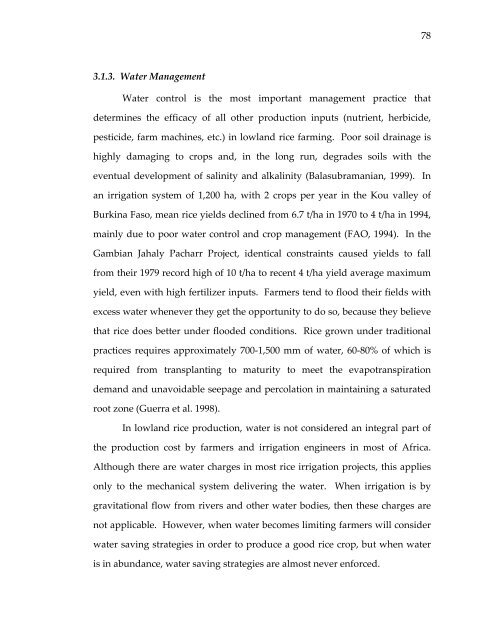Management of rice production systems to increase productivity
Management of rice production systems to increase productivity
Management of rice production systems to increase productivity
You also want an ePaper? Increase the reach of your titles
YUMPU automatically turns print PDFs into web optimized ePapers that Google loves.
3.1.3. Water <strong>Management</strong><br />
Water control is the most important management practice that<br />
determines the efficacy <strong>of</strong> all other <strong>production</strong> inputs (nutrient, herbicide,<br />
pesticide, farm machines, etc.) in lowland <strong>rice</strong> farming. Poor soil drainage is<br />
highly damaging <strong>to</strong> crops and, in the long run, degrades soils with the<br />
eventual development <strong>of</strong> salinity and alkalinity (Balasubramanian, 1999). In<br />
an irrigation system <strong>of</strong> 1,200 ha, with 2 crops per year in the Kou valley <strong>of</strong><br />
Burkina Faso, mean <strong>rice</strong> yields declined from 6.7 t/ha in 1970 <strong>to</strong> 4 t/ha in 1994,<br />
mainly due <strong>to</strong> poor water control and crop management (FAO, 1994). In the<br />
Gambian Jahaly Pacharr Project, identical constraints caused yields <strong>to</strong> fall<br />
from their 1979 record high <strong>of</strong> 10 t/ha <strong>to</strong> recent 4 t/ha yield average maximum<br />
yield, even with high fertilizer inputs. Farmers tend <strong>to</strong> flood their fields with<br />
excess water whenever they get the opportunity <strong>to</strong> do so, because they believe<br />
that <strong>rice</strong> does better under flooded conditions. Rice grown under traditional<br />
practices requires approximately 700‐1,500 mm <strong>of</strong> water, 60‐80% <strong>of</strong> which is<br />
required from transplanting <strong>to</strong> maturity <strong>to</strong> meet the evapotranspiration<br />
demand and unavoidable seepage and percolation in maintaining a saturated<br />
root zone (Guerra et al. 1998).<br />
In lowland <strong>rice</strong> <strong>production</strong>, water is not considered an integral part <strong>of</strong><br />
the <strong>production</strong> cost by farmers and irrigation engineers in most <strong>of</strong> Africa.<br />
Although there are water charges in most <strong>rice</strong> irrigation projects, this applies<br />
only <strong>to</strong> the mechanical system delivering the water. When irrigation is by<br />
gravitational flow from rivers and other water bodies, then these charges are<br />
not applicable. However, when water becomes limiting farmers will consider<br />
water saving strategies in order <strong>to</strong> produce a good <strong>rice</strong> crop, but when water<br />
is in abundance, water saving strategies are almost never enforced.<br />
78
















